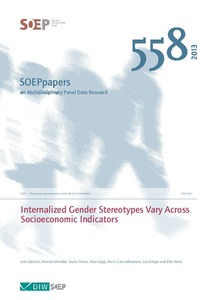Internalized gender stereotypes vary across socioeconomic indicators
"In the following we aim to approach the question of why, in most domains of professional and economic life, women are more vulnerable than men to becoming targets of prejudice and discrimination by proposing that one important cause of this inequality is the presence of gender stereotypes in m...
| Main Authors: | , , , , , , |
|---|---|
| Institution: | ETUI-European Trade Union Institute |
| Format: | TEXT |
| Language: | English |
| Published: |
Berlin
2013
DIW |
| Subjects: | |
| Online Access: | https://www.labourline.org/KENTIKA-19127299124919454719-internalized-gender-stereotype.htm |
| Summary: | "In the following we aim to approach the question of why, in most domains of professional and economic life, women are more vulnerable than men to becoming targets of prejudice and discrimination by proposing that one important cause of this inequality is the presence of gender stereotypes in many domains of society. We describe two approaches employed to measure gender stereotypes: An explicit questionnaire based on rating scales and a newly developed Implicit Association Test assessing gender stereotypes representing instrumentality (i.e., agency) and expressivity (i.e., communion). We first present information on psychometric properties of each stereotype measure designed for this purpose. We then present preliminary data based on the SOEP Innovation Sample 2011 indicating differences in explicit stereotypes with reference to occupational position and income. Implicit stereotypic associations concerning expressivity increased with respondents’ age, stereotypic associations concerning instrumentality increased with household income, particularly among male participants. Finally, stereotypic associations were related simultaneously to occupational position and participants’ gender, such that differences between male and female participants were found in lower occupational positions for the Expressivity IAT and in higher occupational positions for the Instrumentality IAT. This finding indicates that individually held gender stereotypes are related to socioeconomic and social variables." |
|---|---|
| Physical Description: | 11 p. Digital |

